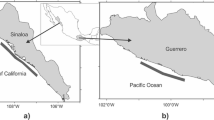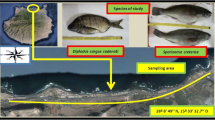Abstract
Tropical coastal lagoons are highly productive environments exhibiting high biodiversity. However, the use of these ecosystems by local communities is of concern, since this generally leads to environmental degradation. The Imboassica coastal lagoon, located in Macaé city, in Northern Rio de Janeiro, is an important ecosystem in the state, however, already displaying signs of anthropogenic impacts. Carnivorous fish Hoplias malabaricus specimens were sampled from this impacted site, as well as from a reference area. Fish from Imboassica Lagoon presented lower condition factor, lower cholinesterase activity, and higher percentage of erythrocyte micronuclei when compared to fish from the reference site. Metals in fish from Imboassica Lagoon were always higher than Encantada Lagoon, with some seasonal differences, where some metals were higher in the rainy season compared to the dry season in muscle tissue, with the exception of Cu, Fe, Sr, and Zn; and in the liver, except for Ba, Cd, Cr, Ni, and Sr. Cr and Mn in the edible muscle portion of the fish were higher than the limits established by Brazilian and International legislations as permissible for human consumption, thus leading to concerns regarding public health risks for the local population that use fish as their main protein source.




Similar content being viewed by others
References
Alkan, N., Alkan, A., Gedik, K., & Fisher, A. (2016). Assessment of metal concentrations in commercially important fish species in Black Sea. Toxicology and Industrial Health, 32, 447–456.
Al-Sabti, K., & Metcalfe, C. D. (1995). Fish micronuclei for assessing genotoxicity in water. Mutation Research/Genetic Toxicology, 343, 121–135.
Amiard, J. C., et al. (2006). Metallothioneins in aquatic invertebrates: their role in metal detoxification and their use as biomarkers. Aquatic Toxicology, 76, 160–202.
Bastos, W. R., et al. (1998). Establishment and analytical quality control of laboratories for Hg determination in biological and geological samples in the Amazon, Brazil. Ciência e Cultura, 50, 255–260.
Bowles, D. (1999). An overview of the concentrations and effects of metals in cetacean species. Journal of Cetacean Research and Management, 1, 125–148.
Calabrese, E. J. (2008). Hormesis: why it is important to toxicology and toxicologists. Environmental Toxicology and Chemistry, 27, 1451–1474.
Calmano, W., et al. (1994). Mobilization and scavenging of heavy metals following resuspension of anoxic sediments from the Elbe river. In C. N. Alpers & D. W. Blowes (Eds.), Environmental geochemistry of Sulfie oxidation (pp. 298–321). Washington, DC: American Chemical Society.
Camara, E. M., Caramaschi, É. P., & Petry, A. C. (2011). Fator de condição: bases conceituais, aplicações e perspectivas de uso em pesquisas ecológicas com peixes. Oecologia Australis, 15, 249–274.
Campbell, P. G. C., Kraemer, L. D., Giguère, A., Hare, L., & Hontela, A. (2008). Subcellular distribution of cadmium and nickel in chronically exposed wild fish: inferences regarding metal detoxification strategies and implications for setting water quality guidelines for dissolved metals. Human and Ecological Risk Assessment, 14, 290–316.
CONAMA, (2005). RESOLUÇÃO No 357, DE 17 DE MARÇO DE 2005. Publicada no DOU n° 053, de 18/03/2005, págs. 58-63.
Eastwood, S., & Couture, P. (2002). Seasonal variations in condition and liver metal concentrations of yellow perch (Perca flavescens) from a metal-contaminated environment. Aquatic Toxicology, 58, 43–56.
Ellman, G. L., Courtney, K. D., Andres Jr., V., & Featherstone, R. M. (1961). A new and rapid colorimetric determination of acetylcholinesterase activity. Biochemical Pharmacology, 7, 88–95.
El-Moselhy, K. M., et al. (2014). Bioaccumulation of heavy metals in some tissues of fish in the Red Sea, Egypt. Egyptian Journal of Basic and Applied Sciences, 1, 97–105.
Filipak Neto, F., Zanata, S. M., Silva de Assis, H. C., Bussolaro, D., Ferraro, M. V. M., Randi, M. A. F., Alves Costa, J. R. M., Cestari, M. M., Roche, H., & Oliveira Ribeiro, C. A. (2007). Use of hepatocytes from Hoplias malabaricus to characterize the toxicity of a complex mixture of lipophilic halogenated compounds. Toxicology In Vitro, 21, 706–715.
Frasco, M. F., Colletier, J. P., Weik, M., Carvalho, F., Guilhermino, L., Stojan, J., & Fournier, D. (2007). Mechanisms of cholinesterase inhibition by inorganic mercury. FEBS Journal, 274, 1849–1861.
Fulton, T. W., (1902). The rate of growth of fishes. 20th annual report of the fishery Board of Scotland. 3, 326-446.
Fulton, M. H., & Key, P. B. (2001). Acetylcholinesterase inhibition in estuarine fish and invertebrates as an indicator of organophosphorus insecticide exposure and effects. Environmental Toxicology and Chemistry, 20, 37–45.
Funk, A. E., et al. (1987). Displacement of zinc and copper from copper-induced metallothionein by cadmium and by mercury: in vivo and ex vivo studies. Comparative Biochemistry and Physiology: Part C, 86, 1–6.
Gorur, F. K., et al. (2012). Radioactivity and heavy metal concentrations of some commercial fish species consumed in the Black Sea region of Turkey. Chemosphere, 87, 356–361.
Hauser-Davis, R. A., Lavandier, R. C., Bastos, F. F., Oliveira, T. F., Ribeiro, C. A. O., Ziolli, R. L., & de Campos, R. C. (2012). Alterations in morphometric and organosomatic indices and histopathological analyses indicative of environmental contamination in mullet, Mugil liza, from southeastern Brazil. Bulletin of Environmental Contamination and Toxicology, 89, 1154–1160.
Hauser-Davis, R. A., Bordon, I. C. A. C., Oliveira, T. F., & Ziolli, R. L. (2016). Metal bioaccumulation in edible target tissues of mullet (Mugil liza) from a tropical bay in southeastern Brazil. Journal of Trace Elements in Medicine and Biology, 36, 38–43.
Heidary, S., et al. (2012). Bioaccumulation of heavy metals Cu, Zn, and Hg in muscles and liver of the stellate sturgeon (Acipenser stellatus) in the Caspian Sea and their correlation with growth parameters Iranian Journal of Fisheries. Sciences, 11, 325–337.
Hennemann, M. C., & Petrucio, M. M. (2011). Spatial and temporal dynamic of trophic relevant parameters in a subtropical coastal lagoon in Brazil. Environmental Monitoring and Assessment, 181, 347–361.
Henriques-de-Oliveira, C., Baptista, D. F., & Nessimian, J. L. (2007). Sewage input effects on the macroinvertebrate community associated to Typha domingensis Pers in a coastal lagoon in southeastern Brazil. Brazilian Journal of Biology, 67, 73–80.
Javed, M., Ahmad, I., Ahmad, A., Usmani, N., & Ahmad, M. (2016). Studies on the alterations in haematological indices, micronuclei induction and pathological marker enzyme activities in Channa punctatus (spotted snakehead) perciformes, channidae exposed to thermal power plant effluent. Springerplus, 5, 761.
Kalnejais, L. H., et al. (2007). Role of sediment resuspension in the remobilization of particulate-phase metals from coastal sediments. Environmental Science and Technology, 41, 2822–2288.
Kasimoglu, C. (2014). The effect of fish size, age and condition factor on the contents of seven essential elements in Anguilla anguilla from Tersakan Stream Mugla (Turkey). Journal of Pollution Effects and Control, 2, 1–6.
Kim, J., & Kang, J. (2016). Oxidative stress, neurotoxicity, and metallothionein (MT) gene expression in juvenile rock fish Sebastes schlegelli under the different levels of dietary chromium (Cr6+) exposure. Ecotoxicology and Environmental Safety, 125, 78–84.
Kozlowsky-Suzuki, B., & Bozelli, R. L. (2002). Experimental evidence of the effect of nutrient enrichment on the zooplankton in a Brazilian coastal lagoon. Brazilian Journal of Biology, 62, 835–846.
Laflamme, J. S., et al. (2000). Interrenal metallothionein and cortisol secretion in relation to cd, cu, and Zn exposure in yellow perch, Perca flavescens, from Abitibi lakes. Canadian Journal of Fisheries and Aquatic Sciences, 57, 1692–1700.
Lemos, C. T., et al. (2001). Evaluation of basal micronucleus frequency and hexavalent chromium effects in fish erythrocytes. Environmental Toxicology and Chemistry, 20, 1320–1324.
Lemos, C. T., et al. (2008). Biomonitoring of genotoxicity using micronuclei assay in native population of Astyanax jacuhiensis (Characiformes: Characidae) at sites under petrochemical influence. Science of the Total Environment, 406, 337–343.
Li, L., Chen, H., Bi, R., & Xie, L. (2015). Bioaccumulation, subcellular distribution, and acute effects of chromium in japanese medaka (Oryzias latipes). Environmental Toxicology and Chemistry, 34, 2611–2617.
Lionetto, M. G., et al., (2013). Acetylcholinesterase as a biomarker in environmental and occupational medicine: new insights and future perspectives. Biomed Research International. 321213 pp. 8.
Luzhna, L., et al. (2013). Micronuclei in genotoxicity assessment: from genetics to epigenetics and beyond. Frontiers in Genetis, 4, 131.
Nunes, B. (2011). The use of cholinesterases in ecotoxicology. In D. M. Whitacre (Ed.), Reviews of environmental contamination and toxicology (pp. 29–59). New York: Springer New York.
Obe, G., Pfeiffer, P., Savage, J. R. K., Johannes, C., Goedecke, W., Jeppesen, P., Natarajan, A. T., Martínez-López, W., Folle, G. A., & Drets, M. E. (2002). Chromosomal aberrations: formation, identification and distribution. Mutation Research, 504, 17–36.
Oliveira, M. M., Silva Filho, M. V., Cunha Bastos, V. L. F., Fernandes, F. C., & Cunha Bastos, J. (2007). Brain acetylcholinesterase as a marine pesticide biomarker using Brazilian fishes. Marine Enviroemental Research, 63, 303–312.
Páez-Osuna, F., Frías-Espericueta, M. G., & Osuna-López, J. I. (1995). Trace metal concentrations in relation to season and gonadal maturation in the oyster Crassostrea iridescens. Marine Environmental Research, 40, 19–31.
Panosso, R. F., et al. (1998). Morfometria das lagoas Imboassica, Cabiúnas, Comprida e Carapebus: implicações para o seu funcionamento e manejo. In: F. A. Esteves, (Ed.), Ecologia das lagoas costeiras do Parque Nacional da Restinga de Jurubatiba e do município de Macaé (RJ), Macaé: Núcleo de Pesquisas Ecológicas de Macaé (NUPEM)/Universidade Federal do Rio de Janeiro pp. 464.
Potter, V. R. (1955). Tissue homogenates. Methods in Enzymology, 5, 10–15.
Rajotte, J., et al., (2003). Indicators of chronic metal stress in wild yellow perch from metal-contaminated environments. In: Conference presentations, mining and environment, 28th annual meeting.
Richetti, S. K., Rosemberg, D. B., Ventura-Lima, J., Monserrat, J. M., Bogo, M. R., & Bonan, C. D. (2011). Acetylcholinesterase activity and antioxidant capacity of zebrafish brain is altered by heavy metal exposure. Neurotoxicology, 32, 116–122.
Sanchez-Galan, S., Linde, A. R., Ayllon, F., & Garcia-Vazquez, E. (2001). Induction of micronuclei in eel (Anguilla anguilla L.) by heavy metals. Ecotoxicology and Environmental Safety, 49, 139–143.
Santos, R. F. B., & Ferreira, M. I. P. (2014). Impactos negativos, positivos e propostas mitigadoras em bacias hidrográficas: estudo de caso da BH da Lagoa Imboassica (Macaé-RJ). Boletim do Observatório Ambiental Alberto Ribeiro Lamego, 8, 77–99.
Saulnier, I., & Mucci, A. (2000). Trace metal remobilization following the resuspension of estuarine sediments: Saguenay Fjord, Canada. Applied Geochemistry, 15, 203–222.
Sinaie, M., Bastami, K. D., Ghorbanpour, M., Najafzadeh, H., Shekari, M., & Haghparast, S. (2010). Metallothionein biosynthesis as a detoxification mechanism in mercury exposure in fish, spotted scat (Scatophagus argus). Fish Physiology and Biochemistry, 36, 1235–1242.
Sipaúba-Tavares, L. H., Guariglia, C. S. T., & Braga, F. M. S. (2007). Effects of rainfall on water quality in six sequentially disposed fishponds with continuous water flow. Brazilian Journal of Biology, 67, 643–649.
Skoog, D. A., et al., (1992). Fundamentals of analytical chemistry. Brooks Cole. Fundamentals of analytical chemistry. Fort Worth, Tex Saunders College Pub. 6th ed.
Squadrone, S., Prearo, M., Brizio, P., Gavinelli, S., Pellegrino, M., Scanzio, T., Guarise, S., Benedetto, A., & Abete, M. C. (2013). Heavy metals distribution in muscle, liver, kidney and gill of European catfish (Silurus glanis) from Italian rivers. Chemosphere, 90, 358–365.
Udroiu, I. (2006). The micronucleus test in piscine erythrocytes. Aquatic Toxicology, 79, 201–204.
van der Oost, R., Beyer, J., & Vermeulen, N. P. E. (2003). Fish bioaccumulation and biomarkers in environmental risk assessment: a review. Environmental Toxicology and Pharmacology, 13, 57–149.
Van Dyk, J. S., & Pletschke, B. (2011). Review on the use of enzymes for the detection of organochlorine, organophosphate and carbamate pesticides in the environment. Chemosphere, 82, 291–307.
Vicari, M. R., Pazza, R., Artoni, R. F., Margarido, V. P., & Bertollo, L. A. C. (2006). Cytogenetics and biogeography: considerations about the natural origin of Hoplias malabaricus (Characiformes, Erythrinidae) on the Iguaçu river. Brazilian Archives of Biology and Technology, 49, 297–303.
Yadav, K. K., & Trivedi, S. P. (2009). Sublethal exposure of heavy metals induces micronuclei in fish, Channa punctata. Chemosphere, 77, 1495–1500.
Author information
Authors and Affiliations
Corresponding author
Rights and permissions
About this article
Cite this article
Coimbra, R.S.C., Mascarenhas, M.S., Saraiva, V.B. et al. Metal loads and biomarker suite responses in a tropical carnivorous fish indicative of anthropogenic impacts in a Southeastern Brazilian lagoon. Environ Monit Assess 190, 564 (2018). https://doi.org/10.1007/s10661-018-6910-1
Received:
Accepted:
Published:
DOI: https://doi.org/10.1007/s10661-018-6910-1




